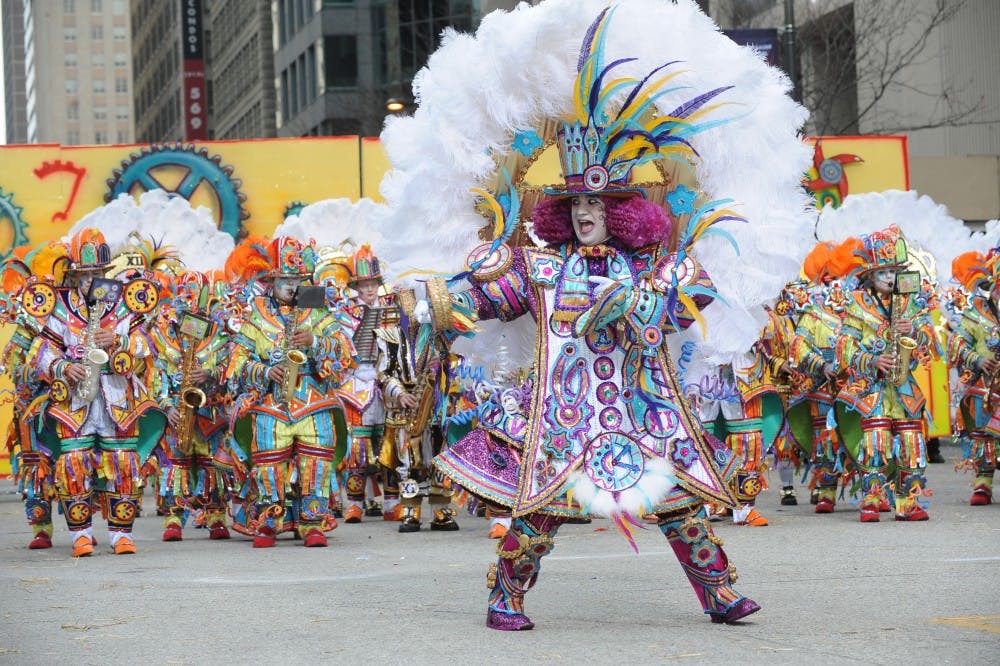On 9:30 a.m. on Jan. 1, while other cities were still sleeping off their New Year’s Eve hangovers, Philadelphia was revving up. The annual Mummers Parade, which has shut down some of Philadelphia’s biggest streets since 1901, is a beloved fixture of the city.
Here’s how it works: brigades, composed mainly of working–class people hailing from the Italian–American and Irish–American neighborhoods of South Philadelphia, spend the year planning, choreographing and designing costumes for a themed performance on New Year’s Day. Most of this happens in the brigades' exclusive clubhouses, many of which line South Philly's 2nd Street. The brigades are divided by performance type and parade style into Wenches, Comics, String Bands and Fancy Brigades, and each division's performances are judged and ranked. A first–place ranking within a division ensures a year of bragging rights in this close-knit, competitive community—and they're far more lucrative than any cash prize. The brigades march along Broad Street for hours, playing music, dancing alongside colorful floats, performing comedy routines, and toying with the thousands of cheering spectators who line the sides of the streets. What perhaps makes Philadelphia mummery most remarkable, however, is its ability to make performers out of some of the least likely suspects. Plumbers and carpenters, police officers and bartenders—they’re all found parading each year, and they’ll more often than not be doing so while wearing between $4,000 and $10,000 worth of sequins.
 They may only march on one day, but Philly offers a year–round chance to learn about the mummers and their history. The Mummers Museum on South Philly's Second Street is a pop of color in an otherwise simple and bar–lined strip of the city. Walking inside is like walking into a kaleidoscope—the millions of sequins carefully sewn onto the displayed suits reflect light in dozens of colors across the walls. The museum also provides a detailed history of the traditions of the Mummers, dating back to their European origins and stories of town marches on "Second Christmas" (Dec. 26). The museum is only open Wednesday through Saturday, but entrance is free.
They may only march on one day, but Philly offers a year–round chance to learn about the mummers and their history. The Mummers Museum on South Philly's Second Street is a pop of color in an otherwise simple and bar–lined strip of the city. Walking inside is like walking into a kaleidoscope—the millions of sequins carefully sewn onto the displayed suits reflect light in dozens of colors across the walls. The museum also provides a detailed history of the traditions of the Mummers, dating back to their European origins and stories of town marches on "Second Christmas" (Dec. 26). The museum is only open Wednesday through Saturday, but entrance is free.
What the museum won't tell you is that Philadelphia’s long–adored tradition has also become one of its most controversial. Their meetings and performances are generally either boozy or followed by a celebratory bar crawl. Countless disruptive and rowdy incidents have outraged parade attendees, and a few performances in recent years have crossed the line into offensive territory. The past few parades have brought hateful slurs, brownface and an entire comic performance dedicated to mocking Caitlin Jenner's transition. In 2015, a Wench Brigade member walked through the streets with a sign reading “Wench Lives Matter," a parody of the #BlackLivesMatter movement. After seeing a 2017 float emblazoned with the words "Make Mummerica Great Again," Penn alumnus Ernest Owens wrote in Philadelphia Magazine that "the Mummers Parade should be rebranded as a White Heritage Parade—for it’s really a celebration of whiteness in all its glory and disgust."
 Despite sensitivity training
coordinated by Philadelphia’s Commission on Human Relations and stringent
pre–parade checks made by city officials, Philly was still nervous as the 2017
parade approached. But when Jan. 1 came, the progressive
aspects of the parade finally outweighed the complaints. The Landi Comic
club, one of the oldest brigade groups in Philadelphia, welcomed some of the
newer, more diverse groups that have popped up in recent years. The Miss Fancy Brigade (comprised of
“Philly’s Phinest drag queens”), the Second 2 None Drill Team (an African–American drumming brigade) and a Trinidadian orchestra are among the newcomers
hoping to create a better image of mummery in the city of Philadelphia. If the
new trajectory of the Mummers continues, they’ll hopefully be able to usher
their traditions into a new era of diversity and inclusivity — without losing a
single sequin.
Despite sensitivity training
coordinated by Philadelphia’s Commission on Human Relations and stringent
pre–parade checks made by city officials, Philly was still nervous as the 2017
parade approached. But when Jan. 1 came, the progressive
aspects of the parade finally outweighed the complaints. The Landi Comic
club, one of the oldest brigade groups in Philadelphia, welcomed some of the
newer, more diverse groups that have popped up in recent years. The Miss Fancy Brigade (comprised of
“Philly’s Phinest drag queens”), the Second 2 None Drill Team (an African–American drumming brigade) and a Trinidadian orchestra are among the newcomers
hoping to create a better image of mummery in the city of Philadelphia. If the
new trajectory of the Mummers continues, they’ll hopefully be able to usher
their traditions into a new era of diversity and inclusivity — without losing a
single sequin.
And you thought your New Year's plans were rowdy.

